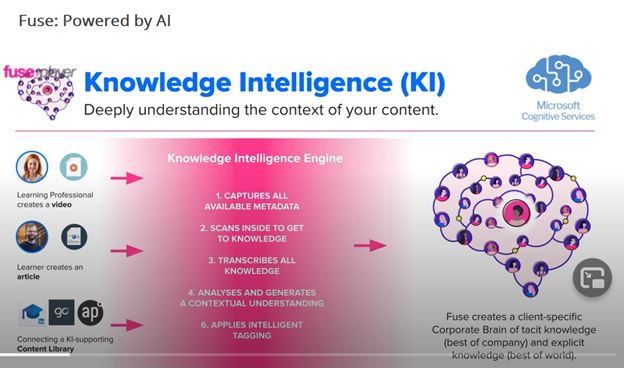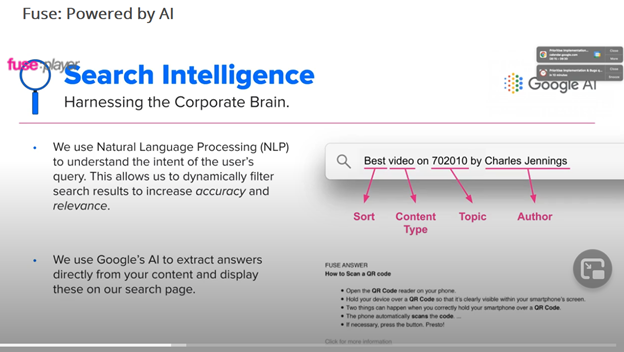
Welcome to part II of the Fuse Knowledge Intelligence Engine series.
By Rhys Giles, Product Director, Fuse
Over the past few years, we’ve rolled out AI and machine learning functions that are now built into Fuse as standard. AI is driving our translation and transcription engines, as well as hyper-personalised micro and macro learning recommendations and unrivalled search. It’s based on Google’s AI and Microsoft Cognitive services woven into our own Knowledge Intelligence Engine to produce intelligence on a number of levels.
While we will have a few big AI-focused product announcements to come in the very near future, we’re excited to share with you a bit of the theory that’s gone into the way we think about AI as a business.
In Fuse, we break down our AI intelligence into three ‘buckets:’ knowledge intelligence, search intelligence and language intelligence. Read along as we tell our AI story, and how it’s building client-specific corporate brains that are driving unrivalled performance and profitability.
We’ve said it before, and we’ll say it again: it’s time to look beyond offering courses that build competence, to providing knowledge that builds expertise.
Our top priority is to give our customers access to knowledge they need to perform in the moment. We’re dedicated to helping our customers build their own company corporate brains, which are effectively extensions of all of the tacit knowledge that can be shared and consumed amongst colleagues, and the explicit, ‘best of world’ outside knowledge.
AI helps our users to deeply understand the context of their content within the corporate brain, whether it's a video created by a leading professional, an article written by an expert employee, or content that comes from a third party library.
In Fuse, the Knowledge Intelligence Engine works with AI and machine learning to capture this content with all its metadata: which is the title, description and tags the authors give the content. It then scans the content and builds out a transcript which is analysed by Microsoft Cognitive Services.
What we get back from Microsoft is a contextually understood transcript with intelligent tagging applied: tags can identify people, places, dates, and times. Fuse builds all of these into its intelligent search, which puts our users in an extremely powerful position to get the knowledge they need, at the exact point they need it.
For example, it means a Fuse user could ask the Knowledge Intelligence Engine to ‘show me all content from 2013,’ and this would quickly and easily be returned. Fuse customers are using this AI-driven Knowledge Intelligence to create a complete corporate brain of tacit knowledge and explicit knowledge.

In Fuse, AI-powered search sits over top of the corporate brain, and search intelligence means that search functionality is designed to understand the intent of any user’s query into Fuse. Ultimately, it’s empowering administrators and learners to create powerful, personalised feeds of knowledge designed to meet learning needs at an exact moment in time.
This goes far beyond searching using keywords. Search intelligence uses Natural Language Processing (NLP) to break down a user’s queries in order to understand them.
AI extracts answers directly from the content transcripts built by the Knowledge Intelligence Engine. If a user searches for ‘most popular video on 702010 by Charles Jennings,’ search intelligence breaks the query down into sort, content type, topic and author.
NLP dynamically filters search results to increase accuracy and relevance. In this way, users get the knowledge they need rather than just returning lists based on keyword searches.

In time, Fuse users will be able to set up knowledge bases so they’re able to mark questions answered. With an official question and answer pair, we can make sure that we get the most accurate and relevant answers in front of people from across a company's corporate brain.
Language Intelligence: Enabling more knowledge to be found regardless of a user's language
With Microsoft’s Cognitive Services, we’re using language intelligence to remove language as a barrier to sharing knowledge. This technology is helping us to generate the most accurate transcripts possible, enabling us to extract knowledge directly from both user generated videos (and yes, this even includes videos taken on your phone), professional and third party videos.
Google Translate will be used to convert the transcripts into any of the 49 languages supported by Fuse. Google Translate is also used to convert comments and conversations in any user’s chosen language, enabling multilingual conversations to happen seamlessly, in- platform.
Outside of the three buckets, we can’t overlook the powerful combination of data and AI, and how they are working together to shape the future of learning. Using both, Fuse is adding predictive performance support based on the data it collects in its Universal Analytics tool. It means we can begin to predict and recommend what knowledge users may need, based on the patterns identified by the system.
Predictive performance support within learning is a new and unique category, and one set to deliver significant performance benefits by shrinking learning time and supporting performance at the point of need. It’s about placing the best and most relevant content as close to the learner as possible so that they know it’s there as soon as they need it.
Our AI bucket list will continue to grow as we keep innovating in learning and discovering new ways to use technology to help our users access the knowledge they need to perform in the moment. Watch this space for our upcoming product announcements, and a series of new articles dedicated to showing just how powerful AI will be in driving the intelligence companies will need to drive demonstrable performance and profit.
We hope you’ve enjoyed part II of the series. Stay tuned for part III: Under the Hood of the Learning Platform of the Future: A New Engine. If you’d like to learn more about powering up knowledge in the flow of work with our new Knowledge Intelligence Engine, download our ebook Knowledge in the Flow of Work: 5 Ways to Power Learning.
© 2022 Fuse Universal - All Rights Reserved
No Comments Yet
Let us know what you think